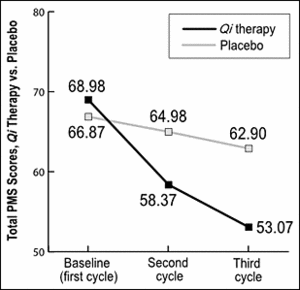Surveys estimate that between 30 percent and 90 percent of all women have suffered from premenstrual syndrome, or PMS, at some point in their lives. PMS is characterized by a variety of physical and emotional symptoms that appear during the week before menstruation and continue for about a week afterwards.
In the United States, severe cases of PMS are often treated with different types of drugs, ranging from synthetic hormones to diuretics to anti-anxiety medications. However, recent studies have shown that a variety of drugless therapies, including relaxation techniques, reflexology, massage and cognitive exercises, may also be effective in alleviating premenstrual symptoms.
Another drugless intervention that may provide relief from PMS is external qigong. In external qigong, a trained practitioner directs his or her own qi outward, with the intention of helping patients clear blockages, remove negative qi and balance the flow of qi in the body, thus relieving pain and helping the body to rid itself of certain diseases. In a recent study published in the Journal of Alternative and Complementary Medicine, scientists in South Korea tested the theory that external qigong could reduce or alleviate the effects of PMS in young women. Their research suggests that qigong can improve many of the symptoms associated with PMS, and that it may work as well as other, more traditional methods of relief.
In the study, 36 women were randomized into two groups. Women in each group received 10 minutes of daily qi therapy (or sham therapy) at 14 days, 7 days, 4 days and 1 day before the menses of two successive menstrual cycles, for a total of eight qi sessions over two cycles. In addition, the women were asked to complete a PMS diary, which documented the severity of 27 common symptoms throughout the study.
External qi therapy was delivered by a female nurse who had practice qi training for eight years and was considered a qigong master. Subjects in the qi therapy group received treatment in the following sequence:
- The qi master centered the self, forming a conscious intent to help the patient while becoming mentally aware of the self as one with the cosmos.
- The qi master's hand moved between three centimeters and 10 centimeters from the patient's body in a head-to-toe pattern, become aware of changes in sensory cues while moving the hand.
- The master concentrated on areas of perceived accumulated tension in the patient's body, and subjectively "projected" qi from her hand. The master than focused her attention on specific perceived directions of energy flow, and finished by holding the patient's feet.
- After completing one side, the patient was turned over and the entire procedure repeated, this time on the other side of the patient's body.
Placebo qi therapy was also performed by a qi master, who mimicked the same techniques and gestures used in real qigong therapy, but without making any effort to emit real qi. To maintain consistency and minimize bias, the same qi master performed the intervention on both groups of patients.
Results
The researchers reported "significant differences" in total PMS symptoms between patients in the qi therapy and control groups. On average, total PMS diary scores for women receiving qi therapy were more than 15 points lower at the end of the study compared to baseline. For women in the placebo group, the average reduction of total PMS scores was less than four points.

On a symptom-by-symptom basis, the scientists also noted "significant improvements" in terms of water retention, pain and negative feelings in the qi therapy group following treatment. They theorized that an improved supply of qi may have harmonized the qi and blood, restoring the health of meridians related to the uterus and accounting for the positive effects.
| Effects of Qi Therapy on Premenstrual Syndrome | |||
| Symptoms | Baseline | Second Cycle | Third Cycle |
| Negative feeling Qi therapy Placebo | 15.29 14.22 | 12.41 14.22 | 12.05 13.87 |
| Pain Qi therapy Placebo | 14.52 14.05 | 11.71 13.65 | 10.03 13.14 |
| Water retention Qi therapy Placebo | 13.67 13.44 | 10.28 12.50 | 9.40 12.38 |
| Note: Values are expressed as mean scores among study participants. | |||
Some limitations were noted in the study. For instance, the positive results seen among women in the qi therapy group were lower than those seen in women given other drugless forms of care in previous studies, such as massage, cognitive therapy and reflexology. However, the researchers pointed out that the other studies used different measurements when evaluating PMS symptoms. To see how qigong measures up against other treatments, they suggested that "a clinically controlled comparison of several different noninvasive therapies for women using the same PMS assessment form would be valuable."
While external qigong appeared to provide a definite benefit for women suffering from PMS, the authors cautioned that more research needs to be conducted, saying that "... additional evaluation of residual effects of qi therapy is needed for clinical applications. They added that further studies "should also examine the possible effects of qi therapy on the hormonal changes associated with the menstrual cycle to clarify the possible mechanisms involved."
Reference
- Jang HS, Soo Lee M. Effects of qi therapy (external qigong) on premenstrual syndrome: a randomized placebo-controlled study. Journal of Alternative and Complementary Medicine 2004;10(3):456-462.



